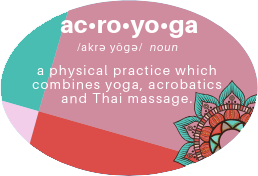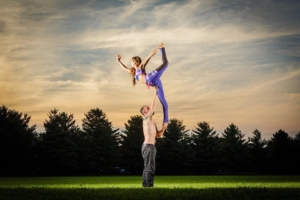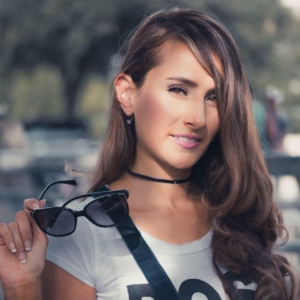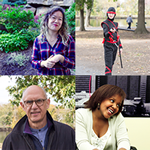Faces Behind the Screen: DeafBlind AcroYoga
Quick Links
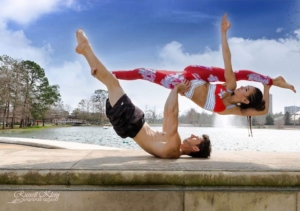
Part one
“Being that my vision allows me to only have 10 degrees worth of a field of view, whereas most people can see about 180 degrees, I have had to develop a new way of communicating with my base [when doing AcroYoga]. I found that by using my main sense of touch I am able to communicate what I want done next by squeezing their hands, using my toes to touch where I want to be placed and even simply by applying more weight on one side of the body. I can really focus and feel my bases body movement as well and understand/interpret what move he/she is asking of my body to be performed next. Talk about true, deep, understanding. This I can relate to first hand being that I’m partially blind and almost completely deaf. All my life I have had to get around primarily by using cues and body language. Unlike most who can easily listen and speak to communicate.
AcroYoga is an important part of my life for reasons that most people never really have to deal with. Communication and understanding, which can be done entirely without speaking. It’s like having your own language with another person that can be expressed and interpreted all without speaking a word. Since this sport plays to my strengths of touch without sight, I have decided to teach and share with others my passion and how easily they can accomplish this too with the right instruction.” – Tanya
“Precisely! DeafBlind people comes with a huge and varying range of hearing loss and vision loss. Some even speak a different language whether it is spoken or signed. However, when it comes to DeafBlind AcroYoga, the disabilities and the barriers virtually disappear. The power of touch literally TOUCH us all and I think that’s what makes DeafBlind AcroYoga so fascinating!
Tanya, out of the blue, contacted us at DeafBlind Camp of Texas and proposed a fundraising event. We immediately agreed. At first, we thought it was going to be some kind of fancy Yoga where we would have our volunteers Support Service Providers (SSPs) work with the DeafBlind individuals whether it be facilitating the information or guiding their movements. Boy, we were completely wrong. Haha! It all worked out though. The DeafBlind individuals would feel and follow the instructors’ movements first before trying it on each other. It worked out beautifully. So much that the AcroYoga community is becoming an extended family for us all.” – Andrew
Part Two
“We’re able to socialize and communicate with people just like the rest of the world. The only difference is that we have a different language and other ways of communicating with each other. It’s an easy language to learn that requires patience and understanding. We have passion and we want people to know that we’re not going to live isolated and silent lives. We can do anything our hearts desire and we are capable of much more.
Being DeafBlind we have balance problems due to our inner ear equilibrium issues. In addition to this most instructors use verbal cues when teaching you the next steps of the progression instead of comprehending that I have a disability and accommodating me to help me learn the next progressions. I have gone to workshops where I have asked instructors to use microphone system that wraps around their arm which connects wirelessly to my hearing aids, so I can hear their instruction, however many instructors are not so kind when asking them to put it on. The easiest part is understanding your body movement and predicting the next progression because it simply feels right. Connecting and applying perfect balance allows you to move gracefully without even thinking about what happens next.” – Tanya
“We all live in a world that seems to crave more and more for instant gratifications. Time is essentially an DeafBlind individual’s biggest barrier. I have read that 80% of the information out there are delivered via the eyes and ears. Boy, that is a lot of information! Certainly, we need more time to process all of those information!
Ironically enough, I would say the easiest and hardest part [of doing acroyoga] is interchangeable. DeafBlind people are extremely tuned in with their own bodies. They can detect a slight change in the air or gravity. Yeah, I am saying we are mutants! Step aside, X-Men! Anyhow… when I am being the base supporting a flyer, I can certainly detect whether the fulcrum feels good or not. I can adjust to the flyer or the flyer can adjust to me. Of course, like Tanya said, we generally have horrible balance. So if the fulcrum is off just too much, just run for your lives!” – Andrew
Part Three
“This may be silly, but [when it comes to technology and websites] many times I have difficulty finding the mouse curser. I alleviate this issue by moving the curser to the farthest top right corner of the screen until I find it again. In addition, the brightness level of the screen can really take a toll on my eyes. I often lower the contrast and brightness levels of the computer monitor so I can function.
The worst thing about DeafBlind is when people underestimate your ability to do what they can do. They assume since I am DeafBlind that I shouldn’t be part of this complex and vision ruled sport. Finding someone that is willing to have the patience to work with me since there’s a communication barrier can be challenging.
The best thing about being DeafBlind, however, is that I can build a stronger bond with people doing AcroYoga through a heightened sense of touch. This allows us them to feel more gratitude for their other senses.” – Tanya
“Everyone is raving all about technology that enables Siri, Alexa, and such. I think that’s amazing. However, I am concerned we would go back to the “dark ages” where everything were purely radio frequencies. Google Home cannot even understand my incredibly and sexy accent. Instead, I often have to disable it and tell it to bring back the text for me to read.
The best thing about being DeafBlind is that we don’t really care about prejudices, bigotry, racism, and whatever else out there. We just don’t have time for that… literally! We accept each other for who we are as individuals. The worst thing about being DeafBlind is sometimes we have too much time to ourselves and that can become boring and lonely. It is not so simple to get in a car and buy milk. You have to plan for transportation, figure out your communication, possibly request for accommodations, and so forth. It can be time-consuming.” – Andrew
Faces Behind the Screen is a storytelling project focusing on communities that benefit from a more accessible web.


